Where and how will search for extraterrestrial life after Mars
Fresh scientific data open up new perspectives for the search for extraterrestrial life in the solar system. With an interval of just a month, published research results that add two more "water" space bodies. Today, liquid water on the surface can only be found on Earth; stripes of wet sand appear in places on Mars; on Saturn's satellite Enceladus, powerful geysers are beating from the under-ice ocean through cracks in the ice crust; and on its neighbor, Titan, cryovulcano erupts in icy lava. Today, among the objects where you can "touch" the water, the satellite of Jupiter Europe, and the dwarf planet Ceres, in the Main Asteroid Belt, are being added.

Europe has long been known as the water world, and it is not the first year that astrobiologists have attracted the attention of themselves. But in the way of researchers searching for protein forms of life, there is not only outer space, high radiation of the Jupiter radiation belt, but also thick ice crust. According to various estimates, the “thick crust” theory assumes an ice thickness of 30-100 kilometers. This distance is more difficult to overcome with modern technologies than a billion kilometers of vacuum.
The current look at the structure of Europe is formed according to Voyager, Galilleo and observations from the Earth. Europe is the smallest of the four "Galilean" satellites of Jupiter. It is characterized by high brightness and smooth surface. The reason for this appearance is in a very young, by space standards, ice crust, which is updated by tectonic processes similar to those of the earth. The smoothness of the surface is one of the indirect evidence of the presence of the subglacial ocean, the depth of which can reach 100 kilometers. Thus, in Europe there is twice as much water as on Earth. Below is the stone mantle, and in the center is assumed a metal core.
')
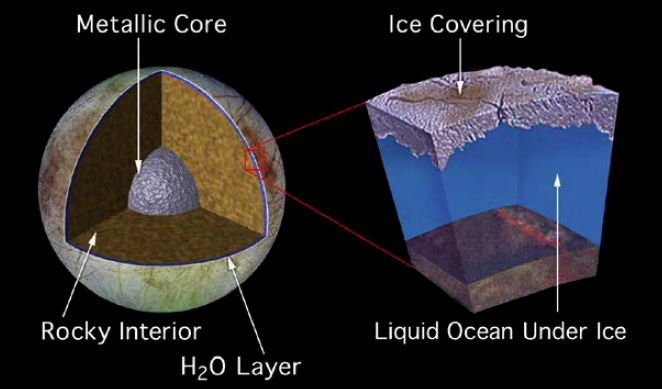
It is believed that red spots and stripes on Europe are the results of water emissions through cracks and breaks in ice, and the color comes from iron and sulfur dissolved in the under-ice ocean. Only three months ago, scientists believed that such emissions occurred in antiquity, and by now they had already stopped.

Unlike the Earth, whose subsoil, as it is believed, mainly heats up radioactive decay, the main “heater” on Europe is the tidal effect of Jupiter. The attraction of the giant planet forces the satellite to change its shape to ovoid as it approaches Jupiter, then to return to the ball as it moves away. Of course, these fluctuations are quite insignificant and the difference between the “egg” and the ball is only 30 meters, but the deformation on the scale of the entire satellite causes considerable heating, capable of supporting an ocean of liquid water.
In December 2013, European perennial observations, with the help of the Hubble telescope and its ultraviolet spectrometer, brought an unexpected result - it turned out that the ice shell of the satellite is not monolithic. In moments of distance from Jupiter, in the ice at the South Pole of Europe, cracks open. Giant jets of water are pulled out of them, which rise to an altitude of 200 km and then fall to the surface. The discharge capacity is impressive - up to 5 tons of water per second.
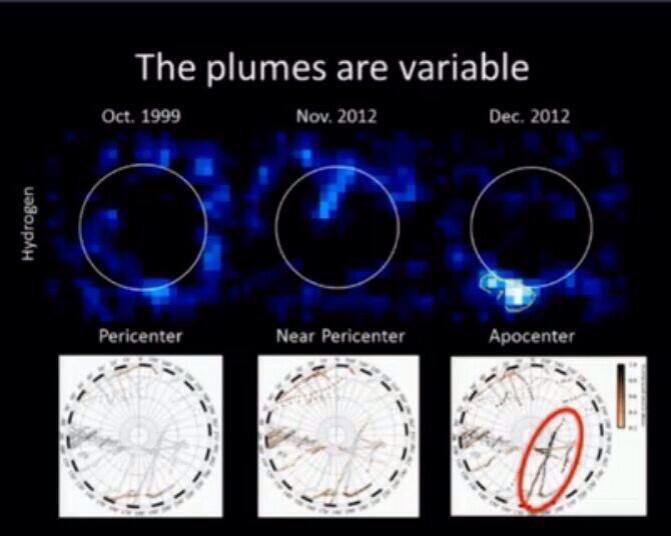
For comparison, the intensity of the geysers of Enceladus is 200 kg per second:
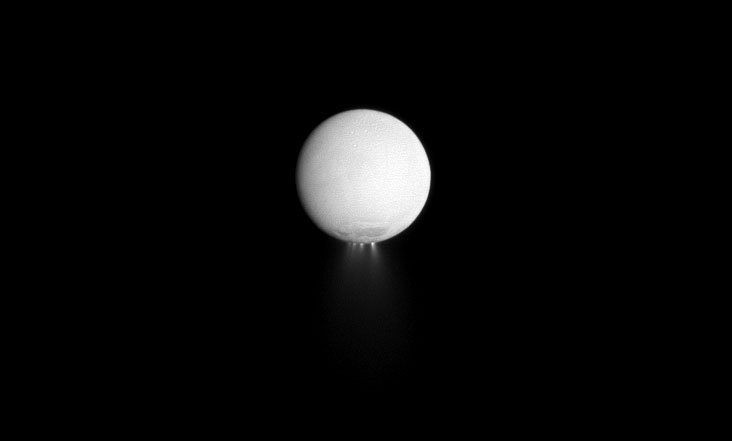
True, the frequency of emissions in Europe is not known: in 15 years only two eruptions were found, but monitoring was not carried out continuously, therefore, perhaps, they occur more often.
Despite the episodicity of emissions, new knowledge opens up new opportunities for exploring Europe and searching for life in the subglacial ocean.
Previously, various concepts and ideas to overcome the ice barrier were considered. Among the proposals were very exotic, such as an atomic reactor, which was supposed to melt a well and launch a submarine under the ice. But to begin with, the idea of a small impactor was considered, which was hoping to simply drive deeper into the ice, without hope of getting to the bottom of the liquid ocean.
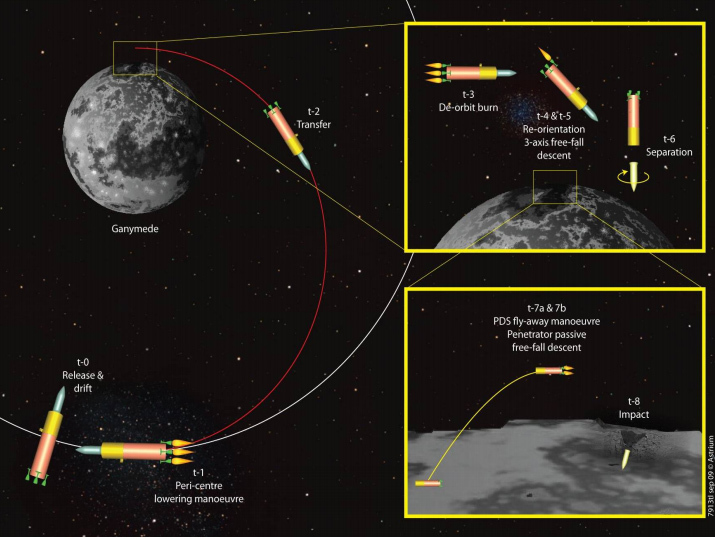
It even came to the test:
The study of Europe with the help of a drill and the search for extraterrestrial life is devoted to the low-budget film Europa Report. Although the only merit of the film I would call the qualitatively depicted weightlessness aboard the ship, one cannot but welcome the attempt of modern cinema to go further than Mars.
Thanks to the current discovery of Hubble, there is no need for a manned expedition or drilling operations at all. Now it’s enough to plan a nonstop mission. The device must rotate in a low orbit waiting for when another eruption will occur. At this point, it is enough for him to fly through the stream to collect samples of fresh water. Although fishing in this way is difficult, traces of microorganisms in the water (or rather, it will already be snow) can be detected. The results will allow us to estimate the probability of extraterrestrial life, and the chances of the presence of giant intelligent squid in the ocean of Europe.
The nearest expedition to Europe - JUICE - is supposed to be sent only in 2022, it will fly to 2030, so the intrigue will remain for a long time. Russia was somehow going to investigate the satellite from the surface, but did not find the possibility of creating a device with sufficient radiation protection, so it reoriented itself to Ganymede:
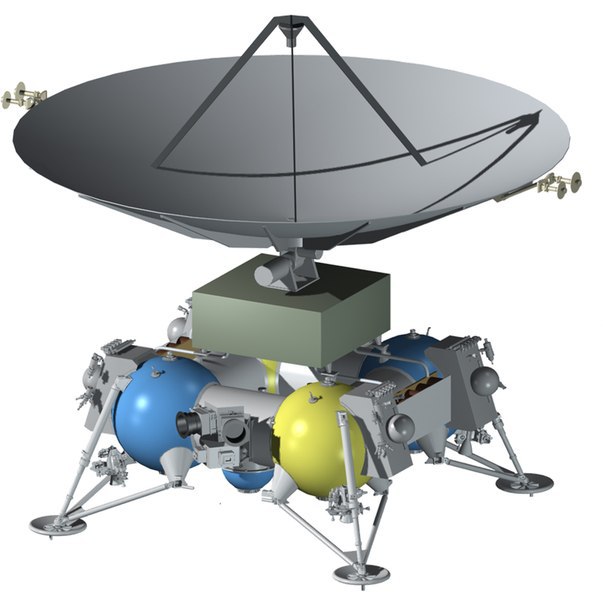
The launch is supposed to be somewhere by 2024, i.e. you can not wait.
In general, Europe seems to be a record holder of deep space in the number of canceled missions to it. Now NASA Juno is flying to Jupiter, but the study of satellites is not included in its scientific program. It remains to hope that the current discovery will spur space agencies and scientific organizations on a more active study of Europe.
However, to search for extraterrestrial water is no longer necessary to fly to Jupiter. Ceres presented the second sensation with the help of the Herschel infrared telescope. Analysis of this dwarf planet, which revolves between Mars and Jupiter, allowed scientists at the European Space Agency to detect water emissions there as well.

The truth here is the allocation of water is much more modest, only 6 kg per second. But they managed to localize them precisely. Emissions are made from two circular structures at the same latitude, but in different hemispheres:

Ceres is a large mysterious body in the asteroid belt. It was discovered in 1801, and managed to spend some time on the planet, until it was “degraded” to an asteroid. In 2006, she partially regained her rank, hitting a number of dwarf planets of the Solar System, along with Pluto, Eris, Hanumea and Makemake.

Ceres is the closest and smallest of the dwarf planets. At the same time, we know not so much about it as about Mars or the moons of Jupiter. The most high-quality images of it were obtained with a Hubble telescope, and they clearly leave much to be desired.
A multispectral infrared survey of the Keck Observatory in Hawaii revealed a bit more surface details.

The average density of Ceres allows us to conclude that it mainly consists of rocks, but the outer side is covered with thick ice crust. It was thought so until recently, but now scientists will have to adjust the model, suspecting the presence of a liquid subglacial ocean. It is believed that in Ceres the water reserves are approximately equal to the fresh water reserves on Earth.

But it affects the lack of information about the planet. While we do not even know what these spots are, from which water evaporates. It can be cryovolcanoes. If so, it will be an incredible discovery. After all, Ceres is too small to allow radioactive decay in the core to melt the subsurface ocean. And nearby there is no giant body capable of causing significant tidal deformations. But all the ideas about landing and drilling operations that were supposed for Europe can now be tested on Ceres. It does not have deadly radiation and it is closer than the moons of Jupiter, so its study is simplified. If you really want to dream, then Ceres is the next potentially attainable object for a manned flight, after Mars. In part, it is even easier to fly to it - there are no problems with the atmosphere and weak gravity does not make it difficult to take off.

But with its supposed eruptions everything can be more prosaic. Ceres is closer to the so-called. " snow line " - the limit beyond which water ice does not evaporate under the direct rays of the sun. The icy satellites of Jupiter are no longer afraid of sunlight, but Ceres has every reason to behave like a comet. But this is not happening. It is believed that the ice on it does not evaporate (sublimated) because the surface is covered with a layer of regolith and hydrated minerals left from falling meteorites. In this case, it may be that the two points from which water is now emitted are just fresh large meteorite craters that exposed deposits of ice, and the “outliers” that Herschel registered are the sublimation of ice under the action of sunlight.
However, it is intriguing that one of the "water" spots glistens brightly in the ultraviolet, and the second is not. In this case, their origin may differ, and at least one of them may be a volcano.

For those who, like me, are interested in Ceres, there is good news: right now, the Dawn space probe is rushing to it at full speed. Despite the disgraceful name for the Russian ear, he worked perfectly during the study of Ceres' neighbor, the giant asteroid West :

At the beginning of 2015, Dawn will also reach Ceres, and this moment can be safely added to the list of the most awaited cosmic events of the next year. I have another interest in Ceres, which is associated with the potential for terraforming of Mars, but this is another story.

Europe has long been known as the water world, and it is not the first year that astrobiologists have attracted the attention of themselves. But in the way of researchers searching for protein forms of life, there is not only outer space, high radiation of the Jupiter radiation belt, but also thick ice crust. According to various estimates, the “thick crust” theory assumes an ice thickness of 30-100 kilometers. This distance is more difficult to overcome with modern technologies than a billion kilometers of vacuum.
The current look at the structure of Europe is formed according to Voyager, Galilleo and observations from the Earth. Europe is the smallest of the four "Galilean" satellites of Jupiter. It is characterized by high brightness and smooth surface. The reason for this appearance is in a very young, by space standards, ice crust, which is updated by tectonic processes similar to those of the earth. The smoothness of the surface is one of the indirect evidence of the presence of the subglacial ocean, the depth of which can reach 100 kilometers. Thus, in Europe there is twice as much water as on Earth. Below is the stone mantle, and in the center is assumed a metal core.
')

It is believed that red spots and stripes on Europe are the results of water emissions through cracks and breaks in ice, and the color comes from iron and sulfur dissolved in the under-ice ocean. Only three months ago, scientists believed that such emissions occurred in antiquity, and by now they had already stopped.

Unlike the Earth, whose subsoil, as it is believed, mainly heats up radioactive decay, the main “heater” on Europe is the tidal effect of Jupiter. The attraction of the giant planet forces the satellite to change its shape to ovoid as it approaches Jupiter, then to return to the ball as it moves away. Of course, these fluctuations are quite insignificant and the difference between the “egg” and the ball is only 30 meters, but the deformation on the scale of the entire satellite causes considerable heating, capable of supporting an ocean of liquid water.
In December 2013, European perennial observations, with the help of the Hubble telescope and its ultraviolet spectrometer, brought an unexpected result - it turned out that the ice shell of the satellite is not monolithic. In moments of distance from Jupiter, in the ice at the South Pole of Europe, cracks open. Giant jets of water are pulled out of them, which rise to an altitude of 200 km and then fall to the surface. The discharge capacity is impressive - up to 5 tons of water per second.

For comparison, the intensity of the geysers of Enceladus is 200 kg per second:

True, the frequency of emissions in Europe is not known: in 15 years only two eruptions were found, but monitoring was not carried out continuously, therefore, perhaps, they occur more often.
Despite the episodicity of emissions, new knowledge opens up new opportunities for exploring Europe and searching for life in the subglacial ocean.
Previously, various concepts and ideas to overcome the ice barrier were considered. Among the proposals were very exotic, such as an atomic reactor, which was supposed to melt a well and launch a submarine under the ice. But to begin with, the idea of a small impactor was considered, which was hoping to simply drive deeper into the ice, without hope of getting to the bottom of the liquid ocean.

It even came to the test:
The study of Europe with the help of a drill and the search for extraterrestrial life is devoted to the low-budget film Europa Report. Although the only merit of the film I would call the qualitatively depicted weightlessness aboard the ship, one cannot but welcome the attempt of modern cinema to go further than Mars.
Thanks to the current discovery of Hubble, there is no need for a manned expedition or drilling operations at all. Now it’s enough to plan a nonstop mission. The device must rotate in a low orbit waiting for when another eruption will occur. At this point, it is enough for him to fly through the stream to collect samples of fresh water. Although fishing in this way is difficult, traces of microorganisms in the water (or rather, it will already be snow) can be detected. The results will allow us to estimate the probability of extraterrestrial life, and the chances of the presence of giant intelligent squid in the ocean of Europe.
The nearest expedition to Europe - JUICE - is supposed to be sent only in 2022, it will fly to 2030, so the intrigue will remain for a long time. Russia was somehow going to investigate the satellite from the surface, but did not find the possibility of creating a device with sufficient radiation protection, so it reoriented itself to Ganymede:

The launch is supposed to be somewhere by 2024, i.e. you can not wait.
In general, Europe seems to be a record holder of deep space in the number of canceled missions to it. Now NASA Juno is flying to Jupiter, but the study of satellites is not included in its scientific program. It remains to hope that the current discovery will spur space agencies and scientific organizations on a more active study of Europe.
However, to search for extraterrestrial water is no longer necessary to fly to Jupiter. Ceres presented the second sensation with the help of the Herschel infrared telescope. Analysis of this dwarf planet, which revolves between Mars and Jupiter, allowed scientists at the European Space Agency to detect water emissions there as well.

The truth here is the allocation of water is much more modest, only 6 kg per second. But they managed to localize them precisely. Emissions are made from two circular structures at the same latitude, but in different hemispheres:

Ceres is a large mysterious body in the asteroid belt. It was discovered in 1801, and managed to spend some time on the planet, until it was “degraded” to an asteroid. In 2006, she partially regained her rank, hitting a number of dwarf planets of the Solar System, along with Pluto, Eris, Hanumea and Makemake.

Ceres is the closest and smallest of the dwarf planets. At the same time, we know not so much about it as about Mars or the moons of Jupiter. The most high-quality images of it were obtained with a Hubble telescope, and they clearly leave much to be desired.
A multispectral infrared survey of the Keck Observatory in Hawaii revealed a bit more surface details.

The average density of Ceres allows us to conclude that it mainly consists of rocks, but the outer side is covered with thick ice crust. It was thought so until recently, but now scientists will have to adjust the model, suspecting the presence of a liquid subglacial ocean. It is believed that in Ceres the water reserves are approximately equal to the fresh water reserves on Earth.

But it affects the lack of information about the planet. While we do not even know what these spots are, from which water evaporates. It can be cryovolcanoes. If so, it will be an incredible discovery. After all, Ceres is too small to allow radioactive decay in the core to melt the subsurface ocean. And nearby there is no giant body capable of causing significant tidal deformations. But all the ideas about landing and drilling operations that were supposed for Europe can now be tested on Ceres. It does not have deadly radiation and it is closer than the moons of Jupiter, so its study is simplified. If you really want to dream, then Ceres is the next potentially attainable object for a manned flight, after Mars. In part, it is even easier to fly to it - there are no problems with the atmosphere and weak gravity does not make it difficult to take off.

But with its supposed eruptions everything can be more prosaic. Ceres is closer to the so-called. " snow line " - the limit beyond which water ice does not evaporate under the direct rays of the sun. The icy satellites of Jupiter are no longer afraid of sunlight, but Ceres has every reason to behave like a comet. But this is not happening. It is believed that the ice on it does not evaporate (sublimated) because the surface is covered with a layer of regolith and hydrated minerals left from falling meteorites. In this case, it may be that the two points from which water is now emitted are just fresh large meteorite craters that exposed deposits of ice, and the “outliers” that Herschel registered are the sublimation of ice under the action of sunlight.
However, it is intriguing that one of the "water" spots glistens brightly in the ultraviolet, and the second is not. In this case, their origin may differ, and at least one of them may be a volcano.

For those who, like me, are interested in Ceres, there is good news: right now, the Dawn space probe is rushing to it at full speed. Despite the disgraceful name for the Russian ear, he worked perfectly during the study of Ceres' neighbor, the giant asteroid West :

At the beginning of 2015, Dawn will also reach Ceres, and this moment can be safely added to the list of the most awaited cosmic events of the next year. I have another interest in Ceres, which is associated with the potential for terraforming of Mars, but this is another story.
Source: https://habr.com/ru/post/212517/
All Articles